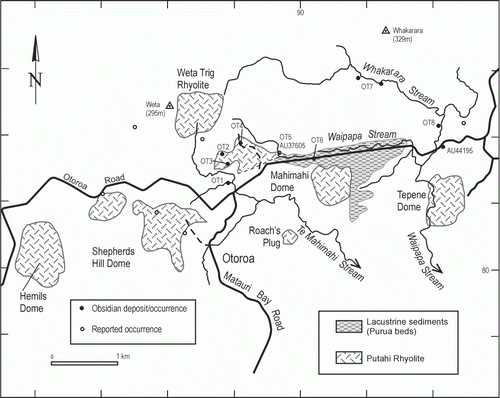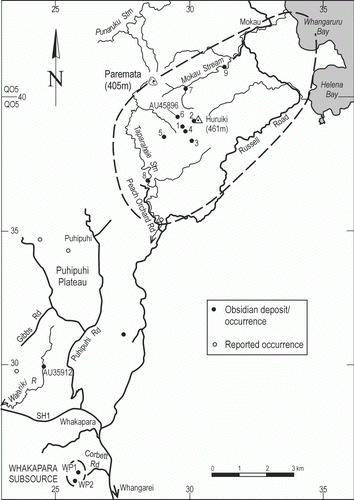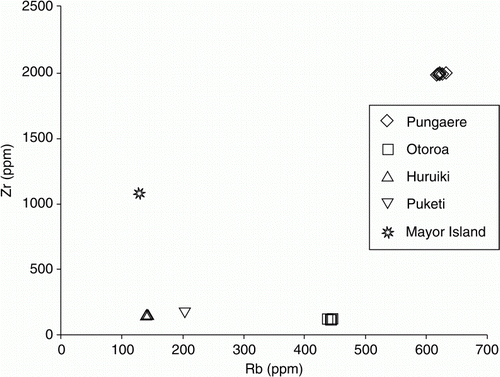Abstract
Four sources of obsidian have previously been recognized in Northland, but more recent field observations and new chemical analyses indicate there are three (Pungaere, Otoroa and Huruiki). Obsidian from these sources can be readily distinguished on the basis of visual characteristics and chemical attributes. The Pungaere obsidian, which is peralkaline in composition, is characterized chemically by unusually high Zr, high Rb, and very low Ba and Sr concentrations. Only two of the sources (Pungaere and Huruiki) appear to have been exploited by pre-European Maori. Available analyses of artefact assemblages suggest that Pungaere obsidian was widely distributed throughout Northland from the fourteenth century, but use of the Huruiki source may have been more limited.
Introduction
Obsidian was widely utilized by pre-European Maori for cutting and scraping purposes, and flakes, cores and pieces of this material have been found in many archaeological sites in New Zealand. Much of the obsidian was procured from Mayor Island in the Bay of Plenty (Sheppard Citation2004), but significant quantities were also obtained from sources in Northland, the Coromandel Volcanic Zone (CitationMoore in press), and Taupo Volcanic Zone (). Reliable information on these sources is important in tracing the origins of obsidian artefacts, and identifying potential transportation routes and trade/exchange networks.
Figure 1 Map of Northland showing the location of obsidian sources and other places mentioned in the text. Inset: Obsidian source regions of the North Island, New Zealand.
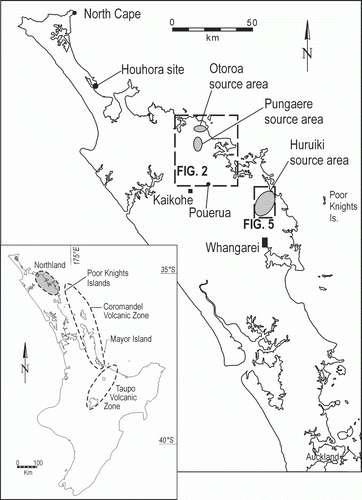
Archaeologists first became aware of the obsidian in Northland in the 1960s (Green Citation1964), though significant deposits of this volcanic glass had been identified during early geological surveys of the region in the Pungaere-Upokorau area northwest of Kerikeri (Bell & Clarke Citation1909) and at Huruiki north of Whangarei (Ferrar Citation1925) (, ). The obsidian in the former area has previously been attributed to two separate sources (Pungaere and Waiare; Ward Citation1973) or collectively referred to as the Kaeo source (Green et al. Citation1967; McCoy et al. Citation2010), resulting in a certain degree of confusion. There is also some uncertainty over the nature and status of another obsidian occurrence recorded by Ward (1973) in the Otoroa-Tepene district east of Kaeo, generally known as the Weta source. Two different kinds of obsidian have been reported in this area (Jones Citation2002).
Figure 2 Map of the Kerikeri-Kaeo area showing the location of obsidian source areas and Puketi Dacite.
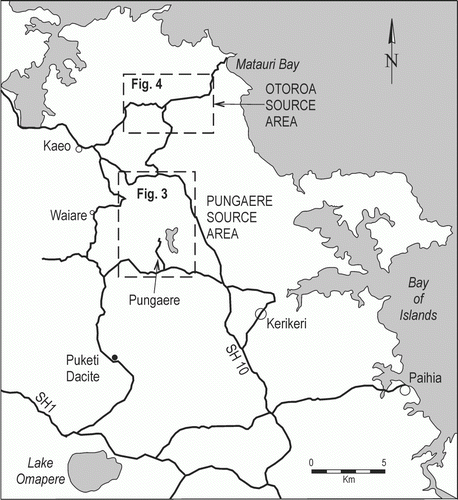
This paper presents new information on the spatial distribution, visual characteristics, petrography, and chemical composition of the obsidians in Northland, with the aim of improving the reliability of future archaeological sourcing studies. It is partly based on a recent study by Lawson (2005), and additional fieldwork in the Kaeo and northern Whangarei areas. No detailed account of the sources near Kaeo has previously been published.
Geological setting
Most of the obsidian in Northland is found in relatively close proximity to deeply weathered rhyolite domes, flows and related volcanic features, which have largely undergone alteration to white clays. The rhyolites are confined to eastern parts of the region between the Whangaroa Harbour and Whangarei, and include both alkaline and peralkaline compositions (Ashcroft Citation1986). They have been previously classified as the Putahi Rhyolites of the Parahaki Volcanic Group (Bowen Citation1974), but are now regarded as part of the basalt-dominated Kerikeri Volcanic Group, of Late Miocene to Quaternary age (Edbrooke & Brook Citation2009). No obsidian has been reported in association with volumetrically minor rhyodacites and dacites of the Kerikeri Volcanics.
Rhyolitic rocks forming the Poor Knights Islands about 20 km off the eastern coast of Northland constitute part of the Whitianga Group, and represent the northernmost extent of the Coromandel Volcanic Zone (Edbrooke & Brook Citation2009; Moore in press).
Description of sources
Pungaere
The obsidian in the Pungaere-Upokorau area is considered to be derived from the Pungaere Dome, a sizeable body of peralkaline rhyolite (pantellerite) with associated flows and tuff deposits (Cameron Citation1986; Lawson Citation2005). The rhyolite is probably of Late Miocene age, based on K/Ar dating of the overlying basalt and of one obsidian boulder (Smith et al. Citation1993), in addition to pollen ages from nearby lacustrine sediments (Evans Citation1993). Pieces of obsidian have been found within and adjacent to the dome margins (in white clay), in lacustrine sediments, in or near stream courses, and exposed on the surface. Although some of the material could be almost in situ, much of it appears to have been transported some distance by colluvial and alluvial processes.
Obsidian deposits
In 1909 geologists JM Bell and EC Clarke reported the presence of ‘numerous blocks of obsidian, ranging from small pebbles to boulders a foot in diameter’ scattered over the tableland 1–2 miles (1.5–3 km) north of Pungaere settlement, and ‘somewhat larger blocks’ in the nearby Waiarewhau Creek (Upokorau Stream) (Bell & Clarke Citation1909:72). On their map they outlined two areas of ‘obsidian fragments’, in the Upokorau Stream area near present day Caprine Rd., and in ‘Landslip Creek’ ().
Figure 3 Detailed map of the Pungaere source area. Extent of Pungaere Dome rhyolite from Evans (1993).
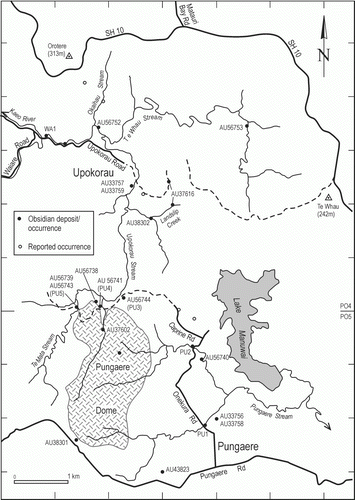
Green et al. (1967), who were apparently unaware of Bell & Clarke's (1909) observations, recorded the occurrence of obsidian boulders at two localities: in a tributary of Upokorau Stream, within ‘white lacustrian (sic) sediments’, and in the upper reaches of Okaihau Stream, which were collectively referred to as the ‘Kaeo source’. Later Ward (1973), who also made no reference to Bell & Clarke (1909), identified two main deposits: detrital material in Upokorau Stream (the same locality recorded by Green et al. Citation1967), and ‘bomb deposited obsidian’ scattered over an area north of Pungaere settlement. These he referred to as the Waiare and Pungaere sources respectively. He made no mention of the Okaihau Stream deposit recorded by Green et al. (1967).
More recently Jones (2002) reported four main obsidian occurrences in the area: along Caprine Rd., in the vicinity of Landslip Creek, along the Kaeo River, and in Okaihau Stream. He also visited the Pungaere locality referred to by Ward (1973) but failed to find any obsidian there and ruled it out as a source. However, obsidian had previously been collected in the Pungaere area by myself (in 1978), Ashcroft (1986), and Cameron (1986). I have not seen any obsidian at the Caprine Rd. locality reported by Jones (2002), or in the lower part of Okaihau Stream. Nevertheless obsidian was obtained west of Caprine Rd. near the mouth of Te Mata Stream, along the Kaeo River, and also in ‘Te Whau Stream’ (Lawson Citation2005). Altogether, obsidian has now been recorded, by both geologists and archaeologists, at more than 16 different locations in the Pungaere-Upokorau district, over an area of about 28 km2 ().
McCoy et al. (2010) recently plotted the location of a number of ‘obsidian finds’ which they regarded as natural occurrences forming part of the Kaeo (Pungaere) source, and suggested that the source area could be very much larger than indicated here. These locations were obtained from the national database of recorded archaeological sites CINZAS (now Archsite), but no details were provided. One of them appears to coincide with the only known outcrop of Puketi Dacite (see later); I have been unable to obtain information on any of the other occurrences.
Considering the similarity in visual characteristics and consistent chemical composition of the obsidian in this area (Lawson Citation2005), there is no reason to continue regarding ‘Waiare’ as a separate source, especially in view of the fact that obsidian has not been recorded near Waiare settlement or in the Waiare Stream. Though other workers have referred to it as the Kaeo source (e.g. Green et al. Citation1967; Seelenfreund & Bollong Citation1989; McCoy et al. Citation2010), in order to avoid any potential confusion with the Weta obsidian occurrence, it is considered ‘Pungaere’ is a preferable name for the source area.
Visual characteristics/petrography
Most of the obsidian from the Pungaere-Upokorau area has a finely to coarsely pitted cortex, though some pieces have a coarsely striated or smooth water worn outer surface. All of the obsidian is black in reflected light, and greyish olive (10Y 4/2) in transmitted light. Translucency is consistently moderate to poor (Moore Citation1988). Most samples display weak or no flow banding, but a few are moderately to strongly flow-banded and very slightly colour banded (black/very dark grey).
The obsidian possesses a good conchoidal fracture, and freshly broken surfaces have a distinctive dull vitreous lustre and finely specked appearance. Obvious phenocrysts (large crystals) are rare, although some pieces contain aggregations or clusters of small crystals up to 4 mm across. Larger xenoliths of grey ?rhyolite have also been observed in some samples. No spherulites are evident in hand specimens.
In thin section the obsidian contains common micro-phenocrysts of alkali feldspar (sanidine or anorthoclase) and numerous, very small needle-like crystals of amphibole (predominantly riebeckite), but no obvious quartz (Lawson Citation2005). Some samples also contain rare iron oxides (possibly ilmenite) and blurry, brownish pseudo-spherulites.
Otoroa (Weta)
Several small rhyolite domes and plugs have been mapped in the Otoroa-Tepene area (Evans Citation1993), all of which are deeply weathered (). The rhyolite at Tepene is considered to be Late Miocene or older, but the age of the remaining domes is unknown.
Obsidian has been found in lacustrine sediments adjacent to the Mahimahi dome, within the soil horizon on hill slopes, in alluvial gravels, and on stream terraces (Lawson Citation2005, pers. obs.). None of the obsidian appears to be in situ, and some of it has probably been transported a considerable distance by colluvial and alluvial processes. Lawson (2005) suggested it may have been derived from the Mahimahi dome, but considering its spatial distribution the obsidian is more likely to have originated from one of the rhyolites further west, possibly Shepherd's Hill dome ().
Obsidian deposits
Ward (1973) described the obsidian in this area as being ‘bomb deposited’ and thinly spread over a wide area south of Weta trig. Samples were subsequently collected by the author (in 1978) and Ashcroft (1986), and recorded at several other localities by Roger Evans during geological mapping of the district between 1993 and 2000 (R Evans pers. comm. 2000).
Further observations have since been made by Jones (2002). He found obsidian at two main locations: (1) over a wide area south and southeast of Whakarara trig, which he informally referred to as the ‘Whakarara deposit’, and (2) in an area north to northeast of Weta trig (although his map and grid reference indicate an area west to southwest of the trig). The obsidian collected in the Whakarara area was said to be mostly identical to the material described by Ward (1973) and Moore (Citation1988), but included some pieces with the same appearance as that from Waiare (Pungaere). During more recent fieldwork a few pebbles and cobbles of obsidian were found along the unnamed stream south of Whakarara trig, but none of the Pungaere type (Lawson Citation2005). Although a single boulder of peralkaline obsidian (AU44195) was previously recorded near Te Pene (Ashcroft Citation1986; Smith et al. Citation1993), the origin of this boulder remains uncertain.
All of the material obtained by Jones (2002) in the Weta trig area was apparently visually identical to the Pungaere obsidian. However, despite an extensive search no obsidian has been found either west to southwest or east of Weta trig, or reported in these areas by landowners. I am therefore unable to confirm Jones’ observations.
To date, six discrete deposits of obsidian have been recorded in an area 1–2 km southeast of Weta trig (OT1–6, ), none of which include any obvious volcanic bombs (cf. Ward Citation1973). In addition to the alluvial material south of Whakarara trig (OT7, 8), isolated pieces of obsidian have also been found in the vicinity of Shepherd's Hill dome, south of Martins Rd (R Evans pers. comm.). Given the relatively wide distribution of obsidian in the Otoroa-Tepene area, and lack of any clear association with the Weta Trig rhyolite, it is recommended that the source area be referred to as Otoroa (following Moore Citation1988).
Visual characteristics/petrography
Most obsidian from this area has a rough, deeply pitted and partly striated cortex, but some pebbles and cobbles are slightly water-worn. It ranges from black to dark grey in colour and is grey in transmitted light, although a single piece of reddish brown material with black streaks has been recorded (Moore Citation1988). The obsidian has a very vitreous lustre and sub-conchoidal fracture. Translucency is generally good (with a smoky tinge) in black obsidian, but moderate to poor in grey varieties. Flow banding ranges from weak to strong, and some pieces are colour banded (grey/black).
The obsidian is characterized particularly by the abundance of phenocrysts, typically 0.5–1.5 mm in size but up to 3 mm across. They are mostly of quartz (clear and glassy) and feldspar (slightly milky). Some samples, particularly of grey obsidian, also contain small black crystals of amphibole, generally less than 0.5 mm but up to 2 mm in length. Clear glassy rounded globules about 1 mm in diameter, apparently composed of quartz, are relatively common. No macroscopic spherulites have been recorded.
In thin section the obsidian consists of larger phenocrysts of quartz and feldspar in a colourless glassy groundmass. The feldspar, which forms better-shaped crystals, is predominantly of the alkali type (sanidine or orthoclase) but includes some plagioclase (albite-oligoclase; Lawson 2005). Most samples also contain abundant, very small crystals of brown to green amphibole (arfvedsonite and riebeckite), and small sub-rounded pseudo-spherulites averaging about 0.2 mm in diameter.
Huruiki
At Huruiki, pebble to cobble-sized pieces of obsidian occur at or near the contact between weathered greywacke and overlying basalt, or within clay directly beneath the basalt, suggesting that the obsidian probably represents a residual or ‘lag’ deposit, which is almost in situ (Moore Citation1982). A few pieces have also been found in the soil horizon on top of the basalt.
Paremata, a prominent hill about two kilometres northwest of Huruiki trig (), has been regarded as the likely source of the obsidian (White Citation1983; Ashcroft Citation1986). Bowen (1974) described it as consisting of finely banded rhyolite, capped by altered tuff, while White (1983:20) refers to remnants of the overlying chilled margin, on the flanks of the rhyolite, as consisting of ‘scattered obsidian boulders’. A brief visit to Paremata in November 2005 revealed that it is composed entirely of finely flow banded rhyolite. No altered tuff was seen on top of the hill, or obsidian boulders on its flanks.
Although the age of the rhyolite at Paremata is unknown, basalt near Huruiki has been K/Ar dated at 5.03 Ma (Smith et al. Citation1993). The fact that obsidian occurs beneath the basalt at Huruiki, and in gravel beds below Horeke basalt flows at Puhipuhi (White Citation1983:20) indicates the parent rhyolite pre-dates the eruption of basaltic lava in the area and is probably of Late Miocene or earliest Pliocene age.
Obsidian deposits
The presence of obsidian at Huruiki was initially reported by Ferrar (1925), and subsequently confirmed by Mansergh (1965), who found ‘abundant fragments’ on the northern side of the hill. Ward (1973) described the source as consisting of nine apparently discrete deposits of ‘bomb material’ over an area of 4 km2 west of Huruiki trig. A more detailed report on the Huruiki obsidian was provided by Moore (1982). He recorded five discrete deposits situated along the prominent ridge southwest of Huruiki trig, containing lumps of obsidian up to 20 cm in diameter. One additional deposit was located by PM Black in 1983 about 500 m west of the trig.
Recent fieldwork has resulted in the discovery of pebbles and cobbles of obsidian in Mokau Stream to the north and Taparahaie Stream to the southwest (). Mansergh (Citation1965) and White (1983) also reported seeing rare well-rounded pebbles on the Puhipuhi Plateau, in stream valleys and old gravel deposits. One pebble (AU35912) was collected by White from the Waiariki River, and another has been found by me in a tributary of Waimamaku Stream, draining the eastern margin of the plateau. In addition, landowners have reported finding boulders of obsidian near the end of Gibbs Rd and in the upper reaches of Whenuarua Stream, although neither of these occurrences has been relocated.
Mansergh (1965) also found obsidian further south on ‘Whakapara hill’, and was informed by local farmers of other occurrences at ‘Carters hill’ near Waro and in the nearby Hikurangi swamp, although he could not confirm their reports. A significant deposit of obsidian has been located at ‘Whakapara hill’ near the end of Corbett Rd, here referred to as the ‘Whakapara subsource’ (), but I have been unable to find any material at ‘Carters hill’. The pebbles and cobbles at Corbett Road appear to be derived from coarse gravel underlying the basalt there.
Visual characteristics/petrography
The visual characteristics of the obsidian at Huruiki have previously been described by Moore (1982, 1988). Most pieces have a pitted and striated outer surface, although the pebbles and cobbles from Mokau and Taparahaie streams are somewhat water worn. The obsidian is generally black in reflected light, but a few pieces are dark grey to greyish black and have a distinctive silky or silvery sheen in strong light. It is grey in transmitted light, though in rare cases slightly brownish. It has a vitreous lustre, moderate to poor translucency, and shows weak to strong flow banding, with slight colour banding in some samples. Phenocrysts are rare to sparse, up to 3 mm in size, and mostly clear and glassy, but include rare black crystals up to 1 mm in length. Many samples also contain small (<1 mm) yellow glassy globules. Although it was previously thought the Huruiki obsidian lacked spherulites (Moore 1982, 1988), a few have recently been recorded. They are light grey and up to 8 mm in diameter.
The material at Corbett Rd has very similar characteristics. The cobble to pebble-sized pieces have a pitted and striated cortex, and some contain deep, elongate holes or have iron oxides adhering to their surface. Rare inclusions (xenoliths) up to 10 mm in diameter are a notable feature.
Thin sections reveal that the phenocrysts consist of quartz, alkali feldspar (sanidine), pyroxene, and yellow-brown amphibole, along with small rods or grains of ilmenite and tiny needles of amphibole (Ashcroft Citation1986; Lawson 2005). The glassy groundmass contains extensive micro-fractures.
Other sources?
There has been some speculation (Brassey Citation1985; Frederickson Citation1998; Johnson Citation1998) about the existence of an additional obsidian source, based on a brief reference by Morgan (Citation1927:72) to obsidian samples collected about 13 miles (21 km) from Kaitaia, apparently from a ‘large dyke-like mass’. Although Morgan presumably sighted the specimens, there are considerable doubts over the reliability of the locality information. If it exists the most likely place for such an occurrence is east or south of Kaitaia, but detailed geological mapping (Evans Citation1993) has not revealed any obsidian in this area.
Puketi dacite
This is an isolated deposit situated between Pungaere and Lake Omapere (), previously described by Brassey (1998). It consists of scattered cobbles and boulders (up to 1 m diameter) of glassy dacite, covering an area of about 50 m2. The locality has been recorded as archaeological site P05/13.
The dacite is a very hard, dense rock with a sub-conchoidal fracture and dull, waxy lustre, and would be better described as a pitchstone than obsidian. The outer cortex is typically deeply pitted (corroded). Fresh surfaces are very dark grey and include small, sparse to common colourless phenocrysts. In thin section the rock consists of a glassy groundmass with phenocrysts of altered feldspar, corroded quartz, pyroxene and rare zircon (Lawson 2005:79).
Geochemistry
Seventeen new chemical analyses were obtained as part of this study by wavelength dispersive X-ray fluorescence (XRF) at the School of Environment, University of Auckland. The data are presented in and , and bivariate plots for Rb, Sr and Zr are illustrated in and . Many of the samples are the same as those previously analysed by Lawson (2005).
Figure 6 Plot of Rb versus Sr for Northland obsidians and Puketi dacite. Mayor Island obsidian (from Sheppard 2004) included for comparison. See and for data.
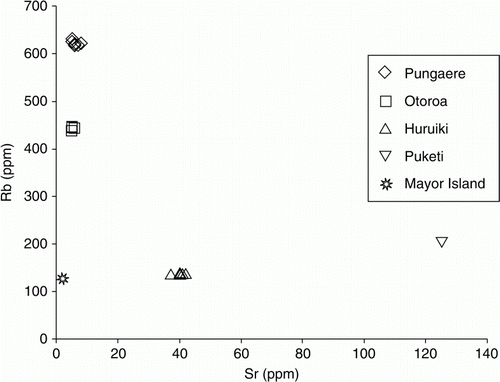
Table 1 Chemical (XRF) analyses of obsidian from the Pungaere and Otoroa source areas, and Puketi Dacite. Analyses by J Wilmshurst, School of Environment, University of Auckland.
Samples were crushed using a tungsten carbide ring grinder. H2O content was estimated by heating weighed sample aliquots to 100oC, and loss on ignition (LOI) obtained by further heating to 1000oC. For analysis 2 g of ignited sample was mixed with 6 g of SPECTRACHEM 12:22 flux and analysed using a Siemens SRS 3000 sequential XRF spectrometer with an Rh tube to obtain major and trace elements. Thirty-six international standards were used for trace element calibration. For his analyses Lawson (2005) used the same methodology but a different flux.
Pungaere
At least 20 XRF analyses of obsidian from the Pungaere-Upokorau area have been obtained by various workers, though most are unpublished. A further six are presented in . No analysis of the isolated boulder near Tepene (AU44195) is available.
Previous studies have shown that the Pungaere obsidian is peralkaline in composition (Smith et al. Citation1977, Citation1993). Peralkaline rhyolites are distinguished from typical (alkaline) rhyolites by higher Na2O and low CaO, MgO and Al2O3 concentrations (Noble Citation1968; MacDonald Citation1974). The Pungaere obsidian is also characterized by unusually high Zr (c. 2000 ppm) and Rb values, elevated levels of other elements (Zn, Y, Th, Ce, Nb) and extremely low Ba and Sr concentrations. The Rb/Sr ratio is the highest recorded for New Zealand obsidians.
The analytical data are consistent, and the obsidian found near Pungaere is chemically indistinguishable from samples collected further north, in the Kaeo River (AU56752) and Te Whau Stream, demonstrating that all of the obsidian in the Pungaere-Upokorau area originated from a common source (Pungaere Dome). This is supported by analyses of rhyolite samples from the dome (Cameron Citation1986; Ashcroft Citation1986; AU37601, 38300). Previous analyses of obsidian from the Upokorau Stream (i.e. Ward's Waiare source) obtained by other workers are very similar to those presented here.
Otoroa
Ten XRF analyses of obsidian from the Otoroa area have previously been obtained, including eight by Lawson (2005), and another four are presented in . The Otoroa obsidian is clearly alkaline in composition, but it has an unusually high total alkali (Na2O + K2O c. 8.6 weight %) content, and in that respect shows some similarities to the Pungaere obsidian. In common with the Pungaere obsidian it also has elevated Rb, Th, Y values, and very low Ba and Sr concentrations (, ), although the Zr/Rb ratio is lower and abundances of Rb, Zr and Nb are markedly lower.
The similarity in composition of the analysed samples, which were collected over a relatively wide area (), indicates the obsidian was derived from a common source. Since there are no analyses of rhyolites in the area, the parent rhyolite cannot be positively identified at present.
Huruiki
XRF analyses of Huruiki obsidian have previously been obtained by Moore (1982), Ashcroft (1986) and Lawson (2005). A further six are presented in . The Huruiki obsidian is also alkaline in composition, but it has a slightly higher total alkali content, and Zr value, than normal (Lawson 2005). The data are consistent, and clearly show that the Whakapara obsidian (WP1 and 2, ) originated from the same parent rhyolite as the Huruiki material.
Table 2 Chemical (XRF) analyses of obsidian from the Huruiki source area. Analyses by J Wilmshurst, School of Environment, University of Auckland.
Puketi dacite
Previous chemical (XRF) analyses of the dacite were provided by Brassey (Citation1988) and Lawson (2005), and a re-analysis of Lawson's sample is presented in . All three analyses are very similar, and the SiO2 values and total alkali (Na2O + K2O) content confirm that the rock is dacitic in composition. It has much higher Ti, Mg, Ca and Sr concentrations than the obsidians (), but a low Ba content, in common with the Pungaere and Otoroa sources.
Source discrimination
As indicated above, there are some significant differences in the visual (macroscopic), petrographic, and chemical characteristics of obsidian from the three sources, which can be used to distinguish between them. The main features of the obsidian in each source area are summarized in .
Table 3 Summary of visual (macroscopic), petrographic (microscopic) and chemical characteristics of Northland obsidians.
Obsidian from the three sources can be readily distinguished on the basis of visual characteristics alone. The greyish olive colour of Pungaere obsidian in transmitted light clearly separates it from both Otoroa and Huruiki material. It is also characterized by a duller lustre and speckled texture, and lacks both spherulites and globules. Otoroa obsidian can probably be distinguished from Huruiki material, in most cases, by the abundance of phenocrysts, better translucency (at least in black obsidian), and poor fracture. Huruiki obsidian is particularly notable for its poor translucency.
Chemically, the three sources can be distinguished from each other on just a few key elements, especially Zr and Rb, but also Ca, Y, Th, Ce and Zn (, ). Zirconium is obviously the most useful element in distinguishing Pungaere obsidian, as its concentration is almost 17 times higher than that of Otoroa obsidian and about 13 times higher than Huruiki material (). Th, Y, Rb, Ce and Zn values are also significantly different. Otoroa and Huruiki obsidian can be clearly distinguished from each other on the basis of Ba, Rb, Sr, Th, Zr, Y and Nb concentrations. Here the most useful elements are Ba (much higher in Huruiki obsidian), Sr (significantly lower in Otoroa), and Rb.
Greater difficulty will probably be experienced in distinguishing Huruiki obsidian from that of some Coromandel sources, since all except one of those (Maratoto) contain at least some material which has poor translucency (Moore Citation2004, in press). However, the scarcity of spherulites in Huruiki obsidian provides a means of separating it from other sources characterized by material with common spherulites, such as Cooks Beach and Hahei. Chemically the Huruiki obsidian is quite similar to that of most Coromandel sources (Moore Citation1982; Lawson 2005), but can probably be distinguished on the basis of Ba and Sr concentrations and Rb/Sr ratio. Although it has similar Zr values to Fanal Island (Moore in press), Rb and the Zr/Rb ratio are much lower.
Pungaere obsidian can usually be easily separated from Mayor Island material on the basis of colour in transmitted light (Mayor Island obsidian is a more distinct olive green), as well as texture and the presence of rough cortex (where present). It also has very much higher Rb and Zr concentrations (, ).
Evidence of exploitation
Since the late 1960s a number of archaeological sourcing studies have been carried out on obsidian artefacts from sites in Northland, Auckland and elsewhere (Davidson Citation1981; Sheppard Citation2004). One of the earliest was by Ward (Citation1974) on 24 pieces from Motutapu Island near Auckland, using XRF. Of these, three were assigned to the Huruiki source with high probability, even though the Zr and Sr values (and Rb/Sr ratio) for only one of the pieces are remotely similar to those established for Huruiki obsidian (Moore Citation1982; Lawson Citation2005). Later, Leach & Anderson (Citation1978) analysed 210 pieces of obsidian from 13 sites at Palliser Bay, also by XRF. Of these nine (4%) were assigned to the Huruiki source with >95% probability. The actual analytical data were not presented, but four of the pieces were green in transmitted light and therefore could not have come from Huruiki.
One of the more important studies involved the analysis of 123 artefacts from six undefended sites at Pouerua in central Northland (), using energy-dispersive XRF (EDXRF) but with some consideration of physical characteristics as well (Brassey & Seelenfreund Citation1984; Brassey Citation1985; Seelenfreund & Bollong Citation1989). The results indicated that at least 58% of the artefacts were from the ‘Kaeo’ (Pungaere/Waiare) source, and 12% from sources other than ‘Kaeo’ or Mayor Island, including perhaps four pieces from Huruiki. Pungaere obsidian was apparently present at all six sites.
In a more extensive study, also using energy-dispersive XRF, Seelenfreund & Bollong (1989) analysed over 4000 artefacts from 58 sites throughout New Zealand. Of these, about 200 (4.6%) were assigned to ‘Northland’ (Pungaere?) and a further 412 (9.6%) to either Northland or Mayor Island. Unfortunately the method was unable to consistently distinguish between Pungaere and Mayor Island obsidian, and failed to discriminate between Huruiki, Fanal Island, Great Barrier, and Coromandel sources. The proportion of obsidian from Huruiki, therefore, is unknown.
Using a completely different approach Moore (1988) sourced 247 obsidian flakes from seven sites near North Cape (), on the basis of visual characteristics alone. Of these at least 49% were probably from the Pungaere source, and this obsidian was represented in all except one site. Only 17 (7%) of the flakes were grey in transmitted light, with possibly two or three being from Huruiki. Although none of the sites have been dated they are probably relatively early (pre-AD 1500), based on the presence of other artefacts and moa bone.
This method has also been tested independently on obsidian artefacts from the Houhora site near Mt. Camel (), which is reliably dated to the early fourteenth century (Furey Citation2002). Earlier energy-dispersive XRF analysis of 300 flakes from this site had indicated that at least 18% were from Northland sources (Seelenfreund & Bollong Citation1989). Based on visual characteristics of 254 of these flakes, 21% were assigned to ‘Northland’ (Pungaere/Waiare) and 4%, which were grey in transmitted light, were attributed to other Northland or Coromandel sources. No Huruiki or Otoroa obsidian was positively identified.
More recently, obsidian from the Huruiki source has been identified by visual and EDXRF analysis in an assemblage from one site at Whangarei Heads, probably dating to the sixteenth or seventeenth century (Phillips Citation2010). Using a portable XRF, McCoy et al. (2010) also analysed 41 obsidian artefacts from a midden on Urupukapuka Island in the Bay of Islands, of which 11 (26%) were assigned to ‘Kaeo’ (Pungaere) and seven (17%) to Huruiki. These assignments were made on the basis of visual comparisons of spectra with those for reference samples.
Despite doubts over the reliability of some earlier studies, there is sufficient evidence to indicate that the Pungaere source was extensively exploited, over a considerable period of time. The obsidian was clearly being utilised at Houhora in the early fourteenth century, relatively early in the North Cape area, and at a later period at Pouerua. It also appears, on the limited data available at present, that small quantities of Huruiki obsidian may have been distributed throughout much of Northland, and at least as far south as Auckland. As yet, there is no indication of former use of the Otoroa obsidian, although this is not surprising given the poor quality of the material. However, no artefact assemblages from sites close to the source have yet been analysed, and it remains possible that the obsidian was exploited locally.
Acknowledgements
Part of the fieldwork for this study was undertaken jointly with Simon Lawson, and I am grateful to him for unrestricted use of information from his thesis. My thanks also to Roger Evans for information, and assistance with fieldwork in the Otoroa area; Ian Smith and John Wilmshurst, School of Environment, University of Auckland, for providing the chemical analyses; and Louise Cotterall for drafting. Comments by two referees resulted in considerable improvements to the paper.
References
- Ashcroft JA 1986 . The Kerikeri Volcanics: a basalt-pantellerite association in Northland, New Zealand . In : Smith IEM . Late Cenozoic volcanism in New Zealand . Royal Society of New Zealand bulletin 23. 48 – 63 .
- Bell JM , Clarke EC 1909 . The geology of the Whangaroa Subdivision, Hokianga Division . New Zealand Geological Survey bulletin 8 .
- Bowen FE 1974 . The Parahaki Volcanics and their associated clays . New Zealand Department of Scientific & Industrial Research bulletin 215 .
- Brassey RJN 1985 . An analysis of some lithic artefact assemblages from Pouerua, Northland, New Zealand . Unpublished MPhil thesis , University of Auckland .
- Brassey , R . 1988 . Pre-European use of dacite obsidian in northern New Zealand . Archaeology in New Zealand , 41 : 179 – 191 .
- Brassey , RJN and Seelenfreund , A . 1984 . Sources of obsidian artefacts from Pouerua, Bay of Islands district . New Zealand Archaeological Association newsletter , 27 : 39 – 42 .
- Cameron JK 1986 . Hydrothermal alteration and mineralisation of Mesozoic sediments and Neogene volcanics, Pungaere, Northland . Unpublished MSc thesis , University of Auckland .
- Davidson J 1981 . The prehistoric exploitation of stone resources in northern New Zealand . In : Leach BF , Davidson J . Archaeological studies of Pacific stone resources . Oxford, B.A.R. International Series 104 . 107 – 190 .
- Edbrooke SW , Brook FJ (comp.) 2009 . Geology of the Whangarei area . Institute of Geological & Nuclear Sciences 1:250 000 geological map 2 .
- Evans R 1993 . Geological map of Northland . Published by the author .
- Ferrar HT 1925 . The geology of the Whangarei-Bay of Islands Subdivision, Kaipara Division . New Zealand Geological Survey bulletin 34 .
- Frederickson , C . 1998 . A previously unrecorded obsidian source in Northland? . Archaeology in New Zealand , 41 : 74 – 76 .
- Furey L 2002 . Houhora. A fourteenth century Maori village in Northland . Bulletin of the Auckland Museum 19 .
- Green , RC . 1964 . Sources, ages and exploitation of New Zealand obsidian: an interim report . New Zealand Archaeological Association newsletter , 7 : 134 – 143 .
- Green , RC , Brooks , RR and Reeves , RD . 1967 . Characterization of New Zealand obsidians by emission spectroscopy . New Zealand Journal of Science , 10 : 675 – 682 .
- Johnson , L . 1998 . A previously recorded Northland obsidian reference . Archaeology in New Zealand , 41 : 192 – 194 .
- Jones M 2002 . A brief prehistory of time . Unpublished PhD thesis , University of Auckland .
- Lawson , SI 2005 . The obsidians of Northland: a physical, petrological and geochemical study . Unpublished MSc thesis , University of Auckland .
- Leach , BF and Anderson , AJ . 1978 . The prehistoric sources of Palliser Bay obsidian . Journal of Archaeological Science , 5 : 301 – 307 . doi: 10.1016/0305-4403(78)90047-X
- McCoy , MD , Ladefoged , TN , Blanshard , A and Jorgensen , A . 2010 . Reconstructing lithic supply zones and procurement areas: an example from the Bay of Islands, Northland, New Zealand . Journal of Pacific Archaeology , 1 : 174 – 183 .
- MacDonald , R . 1974 . Nomenclature and petrochemistry of the peralkaline oversaturated extrusive rocks . Bulletin Volcanologique , 38 : 498 – 516 . doi: 10.1007/BF02596896
- Mansergh GD 1965 . A study of the Kerikeri Volcanics north of Whangarei . Unpublished MSc thesis , University of Auckland .
- Moore , PR . 1982 . Obsidian deposits at Huruiki, Northland . New Zealand Archaeological Association newsletter , 25 : 240 – 246 .
- Moore PR 1988 . Physical characteristics of New Zealand obsidians and their use in archaeological sourcing studies . Unpublished report .
- Moore PR 2004 . The obsidian sources of Coromandel Peninsula and Fanal Island . Peninsula Research report 2004–04 .
- Moore in press . Obsidian sources of the Coromandel Volcanic Zone, northern New Zealand . Journal of the Royal Society of New Zealand .
- Morgan PG 1927 . Minerals and mineral substances of New Zealand . New Zealand Geological Survey bulletin 32 .
- Noble , DC . 1968 . Systematic variation of major elements in comendite and pantellerite glasses . Earth & Planetary Science Letters , 4 : 167 – 172 . doi: 10.1016/0012-821X(68)90011-3
- Phillips C 2010 . Further artefact analysis: addendum to archaeological investigation, midden Q07/571, 2567 Whangarei Heads Road, Urquharts Bay (Historic Places authority 2007/25) . Unpublished client report .
- Seelenfreund A , Bollong C 1989 . The sourcing of New Zealand archaeological obsidian artefacts using energy dispersive XRF spectroscopy . In : Sutton D . Saying so doesn't make it so: papers in honour of B. Foss Leach . New Zealand Archaeological Association Monograph 17. 168 – 189 .
- Sheppard PJ 2004 . Moving stones: comments on the archaeology of spatial interaction in New Zealand . In : Furey L , Holdaway S Change through time. Fifty years of New Zealand archaeology . New Zealand Archaeological Association Monograph 26 . 147 – 168 .
- Smith , IEM , Chappell , BW , Ward , GK and Freeman , RS . 1977 . Peralkaline rhyolites associated with andesitic arcs of the Southwest Pacific . Earth and Planetary Science Letters , 37 : 230 – 236 . doi: 10.1016/0012-821X(77)90167-4
- Smith , IEM , Okada , T , Itaya , T and Black , PM . 1993 . Age relationships and tectonic implications of late Cenozoic basaltic volcanism in Northland, New Zealand . New Zealand Journal of Geology & Geophysics , 36 : 385 – 393 . doi: 10.1080/00288306.1993.9514583
- Ward , GK . 1973 . Obsidian source locations in the North Island of New Zealand . New Zealand Archaeological Association newsletter , 16 : 85 – 103 .
- Ward , GK . 1974 . Source of obsidians from the Motutapu undefended site N38/37 . Records of the Auckland Institute & Museum , 11 : 13 – 14 .
- White GP 1983 . Hydrothermal alteration and mineralisation in a fossil geothermal system at Puhipuhi, Northland, New Zealand . Unpublished MSc thesis , University of Auckland .
